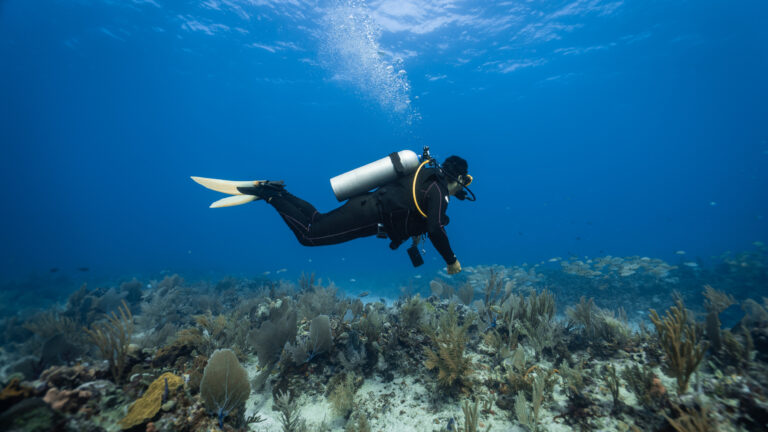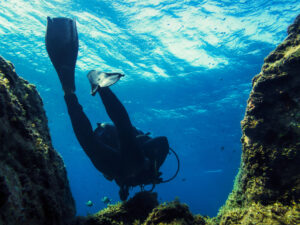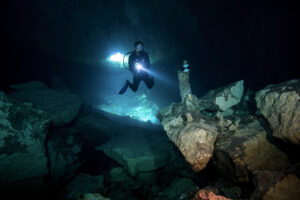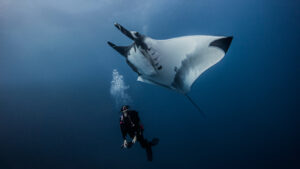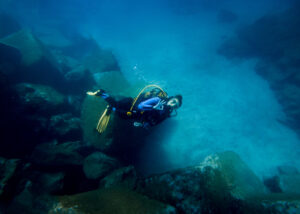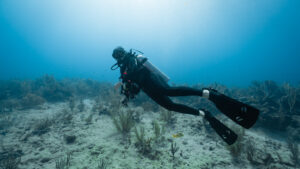What is a Diver Propulsion Vehicle?
A Diver Propulsion Vehicle (DPV), also known as an underwater scooter, is a motorized device used by scuba divers to increase their range underwater with minimal physical exertion. By holding onto the DPV, divers can be pulled through the water at various speeds, allowing them to cover greater distances and access dive sites that would otherwise be challenging to reach. DPVs are used in various types of diving, from recreational to technical and even military applications, providing significant benefits in terms of efficiency and safety.
History and Development
The history of Diver Propulsion Vehicles dates back to World War II, when military forces sought ways to enhance the mobility of divers for covert operations. Early designs were rudimentary, often involving modified torpedoes that divers could ride. These early models were used by combat divers, or “frogmen,” for missions such as reconnaissance, sabotage, and underwater demolition.
Post-war advancements in technology led to the development of more sophisticated DPVs. In the 1960s and 1970s, with the rise of recreational scuba diving, commercial manufacturers began producing DPVs for civilian use. These early recreational models were heavier and bulkier than modern versions, with limited battery life and speed. However, they opened up new possibilities for underwater exploration, allowing divers to explore larger areas with less effort.
The evolution of DPV technology has continued over the decades, driven by improvements in battery technology, materials science, and hydrodynamics. Modern DPVs are lightweight, more powerful, and highly efficient. They incorporate advanced features such as variable speed controls, improved buoyancy characteristics, and enhanced safety mechanisms. Today, DPVs are an essential tool for many types of diving activities, from leisurely underwater tours to complex technical dives in challenging environments.
Types of DPVs
Recreational DPVs are designed for the general diving public. These models are typically lightweight and easy to handle, making them suitable for a wide range of divers. They are often used for fun and exploration on dives, allowing users to cover more ground and see more of the underwater environment without expending too much energy. These DPVs are usually more affordable and accessible than their technical and commercial counterparts.
Technical DPVs are built for more demanding diving scenarios, such as cave diving, wreck diving, and deep-sea exploration. These DPVs are typically more robust, with larger battery capacities and greater propulsion power. They are designed to handle the rigors of challenging dive conditions and can operate at greater depths. Technical DPVs often include advanced features such as redundant safety systems, enhanced maneuverability, and extended operational ranges, making them indispensable tools for experienced divers undertaking complex and prolonged dives.
Military and commercial DPVs are specialized vehicles used for a variety of professional applications. Military DPVs are used by naval forces for covert operations, underwater reconnaissance, and mine countermeasures. These models are often highly specialized, featuring stealth capabilities, advanced navigation systems, and the ability to carry additional equipment. Commercial DPVs, on the other hand, are used in industries such as underwater construction, inspection, and repair. These vehicles are designed for reliability and durability, capable of performing demanding tasks in harsh underwater environments.
Components and Design
The core component of a DPV is its motor and propulsion system. The motor, usually electric, drives a propeller that provides thrust to move the DPV through the water. Modern DPVs utilize brushless motors, which are more efficient and require less maintenance than traditional brushed motors. The propulsion system is designed to balance power and efficiency, allowing for sustained operation over long distances.
Batteries are another crucial component, providing the necessary power for the DPV’s operation. Advances in battery technology have led to the use of lithium-ion batteries, which offer higher energy densities and longer operational times compared to older lead-acid batteries. These batteries are lighter and more compact, contributing to the overall efficiency and portability of the DPV. Battery management systems ensure safe operation by monitoring voltage, temperature, and other parameters.
Buoyancy and hydrodynamics are key design considerations for DPVs. The vehicle must maintain neutral buoyancy to ensure it does not sink or float uncontrollably. This is achieved through careful weight distribution and the use of buoyancy control devices. The hydrodynamic shape of the DPV minimizes drag, allowing it to move efficiently through the water. Streamlined designs reduce resistance, increasing speed and battery life.
Control mechanisms and safety features are integral to the operation of a DPV. Basic controls include a throttle to adjust speed and directional controls for maneuvering. Advanced models may include features such as depth gauges, battery status indicators, and automatic shutoff systems to prevent runaway conditions. Safety features such as emergency buoyancy aids, pressure relief valves, and quick-release mechanisms enhance diver safety and ease of use.
Operational Techniques
Operating a DPV requires understanding its controls and handling characteristics. The basic operation involves holding onto the DPV and using the throttle to control speed. Divers must be aware of their surroundings and maintain situational awareness to avoid collisions with underwater obstacles or other divers. Proper trim and buoyancy control are essential to ensure stable and efficient movement through the water.
Effective use of a DPV involves learning specific techniques. For instance, using a DPV in tandem with good buoyancy control can reduce drag and improve maneuverability. Divers often adopt a streamlined position to minimize resistance and maximize efficiency. When navigating through tight spaces such as caves or wrecks, precise control and gentle adjustments are necessary to avoid stirring up sediment and reducing visibility.
Safety protocols are crucial when using a DPV. Divers should always perform a pre-dive check to ensure the DPV is functioning correctly. This includes inspecting the battery charge, motor operation, and control systems. During the dive, it is important to monitor the battery level to avoid being stranded with a depleted battery. In case of a malfunction, divers should be prepared to abandon the DPV and ascend safely using traditional methods. Familiarity with emergency procedures, such as ditching the DPV or managing an uncontrolled ascent, is vital for diver safety.
Applications of DPVs
Recreational diving benefits significantly from the use of DPVs. These vehicles enhance the overall experience by allowing divers to cover more ground and explore new areas. For instance, DPVs are popular in locations with large underwater environments, such as coral reefs or marine reserves. Divers can traverse expansive areas without tiring, enabling them to see more marine life and underwater landscapes. DPVs also facilitate group diving, as divers can stay together more easily when using propulsion assistance.
In technical diving, DPVs are indispensable tools for exploring challenging underwater environments. Cave divers use DPVs to navigate long, submerged passageways that would be difficult or impossible to traverse by swimming alone. The increased range and speed provided by DPVs allow technical divers to reach remote sections of cave systems, conduct detailed surveys, and perform complex tasks. Similarly, wreck divers use DPVs to access deep or distant shipwrecks, enabling thorough exploration and documentation.
Commercial and military applications of DPVs are diverse and demanding. In commercial diving, DPVs are used for tasks such as underwater construction, maintenance, and inspection. For example, divers working on offshore oil rigs or underwater pipelines use DPVs to quickly move between work sites, carry tools, and perform inspections. Military applications include underwater reconnaissance, mine detection, and special operations. Military DPVs are often equipped with advanced navigation systems, communication devices, and payload capabilities, making them versatile tools for a wide range of missions.
Advantages and Limitations
The advantages of using DPVs in diving are numerous. One of the primary benefits is the increased range and dive time they provide. By reducing the physical effort required to move through the water, DPVs allow divers to conserve energy and air, extending the duration and distance of their dives. This is particularly beneficial in technical and commercial diving, where reaching specific sites or completing tasks efficiently is critical. DPVs also enable divers to cover more ground, enhancing the overall diving experience by allowing them to explore larger areas and encounter more marine life.
However, there are also limitations and challenges associated with DPVs. Maintenance and cost are significant considerations. DPVs are complex machines that require regular upkeep to ensure reliable operation. Battery maintenance, motor servicing, and routine inspections are necessary to keep the vehicle in good working condition. The initial cost of purchasing a DPV can be high, and ongoing maintenance costs can add up over time.
Handling and safety issues are also important factors to consider. DPVs can be challenging to control, especially for inexperienced divers. The increased speed and maneuverability can lead to accidents if not managed properly. Collisions with underwater obstacles or other divers are potential risks. Additionally, in the event of a malfunction, divers must be prepared to manage the situation safely. This includes knowing how to ditch the DPV and ascend using traditional methods.
Future Trends and Innovations
The future of DPV technology is promising, with ongoing advancements expected to enhance performance and usability. Improvements in battery technology will likely lead to longer operational times and faster charging capabilities. The development of more efficient motors and propulsion systems will increase speed and reduce energy consumption. Additionally, advancements in materials science will result in lighter and more durable DPV designs.
Potential future applications of DPVs are varied and exciting. In recreational diving, we may see the integration of DPVs with augmented reality (AR) systems, providing divers with enhanced navigation and informational displays. Technical divers might benefit from DPVs equipped with advanced sensors and communication devices, facilitating better data collection and real-time collaboration. In commercial and military sectors, autonomous and remotely operated DPVs could revolutionize underwater operations, enabling tasks to be performed with minimal human intervention.
The integration of DPVs with other diving technologies is another area of interest. For example, combining DPVs with rebreathers could significantly extend dive times and depths, opening up new possibilities for exploration and research. Similarly, the use of DPVs in conjunction with underwater drones could enhance underwater mapping and surveying capabilities, providing detailed and accurate data for various applications.
Key Takeaways
Diver Propulsion Vehicles are essential tools in the world of scuba diving, offering significant benefits in terms of range, efficiency, and safety. From their historical origins to modern advancements, DPVs have evolved into versatile devices used in recreational, technical, and professional diving. Despite their advantages, DPVs also present challenges that require careful handling and maintenance. Looking ahead, ongoing innovations promise to further enhance DPV technology, expanding their applications and improving their performance. Overall, DPVs play a crucial role in enhancing underwater experiences and enabling divers to achieve their goals more effectively.

